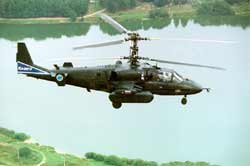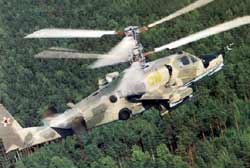Russia to export 10-15 Ka-52 Alligator helicopters annually - designer
03 Nov 2008
Vladivostok: Russia will very likely be exporting anything between 10-15 Ka-52 Alligator (NATO designation-Hokum B) attack/reconnaissance helicopters annually, according to Kamov design bureau's chief designer Sergei Mikheyev. Production of these helicopters began Wednesday at the Progress aircraft maker, located in Russia's Far East.
 "We have been involved in talks on exports of the Ka-52...and 10-15 helicopters annually appears to be a reasonable number," Sergei Mikheyev said. Names of customers or the value of delivery contracts remained unspecified even as Mikheyev expressed the hope that the Alligator would meet the high demand in the global arms market.
"We have been involved in talks on exports of the Ka-52...and 10-15 helicopters annually appears to be a reasonable number," Sergei Mikheyev said. Names of customers or the value of delivery contracts remained unspecified even as Mikheyev expressed the hope that the Alligator would meet the high demand in the global arms market.
The Ka-52, a twin-seat derivative of the Ka-50 Hokum-A Black Shark attack helicopter, is designed primarily for reconnaissance and target designation purposes, and may be utilised as a command helicopter to coordinate group combat helicopter operations.
Reportedly, it is similar to the US AH-64 Apache attack helicopter and is also intended to replace the Russian Army's fleet of Mi-8 Hip and Mi-24 Hind combat helicopters. "The aircraft that will be put in service with the Russian army in the future must not be inferior to those used by a potential enemy," Mikheyev said.
Ka-52 Alligator (NATO-Hokum B)
The multi-role, all-weather, Ka-52 Alligator is a twin-seat derivative of the attack Ka-50 Black Shark and is intended for a wide range of combat tasks in day and night conditions.It differs from its predecessor the Ka-50 through a wider nose and a twin-seat crew cockpit where the seats are arranged side-by-side.
 The tandem arrangement is complemented by a dual control capability that allows both pilots full flight control without any limitations.
The tandem arrangement is complemented by a dual control capability that allows both pilots full flight control without any limitations.
An on-board multi-functional avionics suite ensures performance of navigational and combat tasks in any kind of weather or season. The avionics suite is a multi-plexed, multi-level digital computer-based system with large storage capacity and high speed. Observation, search and targeting systems comprising head-mounted displays are used for day/night as well as all-weather detection of specified targets that can be targeted through optical, TV, laser, IR and radar equipment.
An understanding of the Ka-50's combat capabilities, with which the Alligator shares all its other combat features, will provide a glimpse of the Alligator's combat potential.
Ka-50 Black Shark (NATO- Hokum-A) The Ka-50 was commissioned as a concept in 1984 as a potential replacement for the obsolete Mi-24 Hind (Crocodile), which had performed very well in the 1979-1989 Afghan War. The Ka-50 packed a more devastating punch than the Mi-24, and was capable of flying reconnaissance and combat missions round the clock and in any weather.
The Ka-50 was commissioned as a concept in 1984 as a potential replacement for the obsolete Mi-24 Hind (Crocodile), which had performed very well in the 1979-1989 Afghan War. The Ka-50 packed a more devastating punch than the Mi-24, and was capable of flying reconnaissance and combat missions round the clock and in any weather.
It could not only take on armoured formations and fortifications but also engage aerial targets. Iot was designed to sustain intense enemy fire.
The heavily armoured cockpit cannot be pierced by 12.7-mm heavy machine-gun bullets or the 20-mm M-61 Vulcan six-barreled Gatling-style gun at 100 metres.
The Ka-50 became the first helicopter in history to receive the K-37-800 ejection seat, developed by the Zvezda research and production association (NPO), which supplies ejection seats for the Sukhoi, Mikoyan-Gurevich and Tupolev aircraft corporations. This facility allows the Ka-50 helicopter pilot to eject safety like fighter pilots.
The Ka-50's avionics also ensure automatic flight and landing in case of a pilot black out.
Such advanced avionics capabilities, says Kamov general designer, Sergei Mikheyev, who also supervised the Ka-50 project, provides the pilot not only with the most advanced flight capabilities but the heavy armour protection also gives him the confidence to openly confront enemy armoured formations and fortifications.
The Ka-50 carries a 2A42 30-mm gun, which is atleast twice as heavy as the cannon carried by the AH-64 Apache and its range and armor penetrating capacity exceeds the Apache's several times over.
The helicopter's dirt, dust and water-resistant cannon also facilitates low-altitude combat missions.
The Ka-50 has a unique custom-made Vikhr (Vortex) anti-tank guided missile, developed at the Tula-based Instrument Design Bureau headed by Arkady Shipunov, member of the Russian Academy of Sciences.
These automatic, supersonic and laser-guided missiles pierce thick armor (up to 0.9 meter) and cannot be diverted by enemy ECM (electronic counter-measures) systems. They missiles can attack tanks, mechanized infantry combat vehicles, self-propelled guns, medium-range and shorter-range missile launchers, as well as aerial targets.
The Ka-50's computer can receive target acquisition data from other helicopters, including the Ka-52, as well as from AWACS-type early warning planes, ground reconnaissance systems and scouts. When such data is made available the computer selects high-priority, or the most dangerous targets, within firing range.
The pilot then activates the automatic sighting system, which aligns his guided missiles with the target, and push several buttons. The missiles can destroy all targets up to a range of10 km.
Apart from the 12 Vikhr guided missiles, the Ka-50 can also carry 80 B-8V20A rocket projectiles, which too have great capabilities.
The Ka-50 can execute a 180-degree banked turn at full speed, fire a burst at the enemy and continue flying along a preset route. Such capabilities are possible only because of the co-axial design, which is a Kamov spaeciality.
The helicopter's two co-axial three-blade rotors regulate lift and enable it to move in the required direction.






















